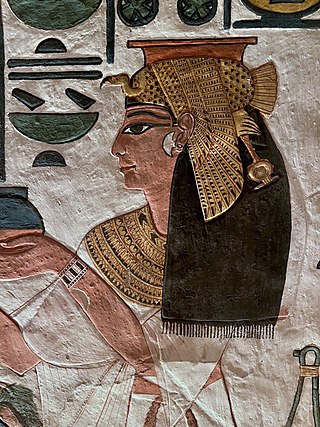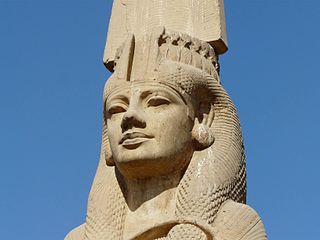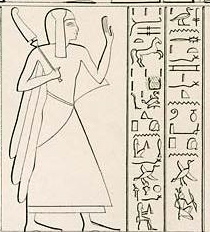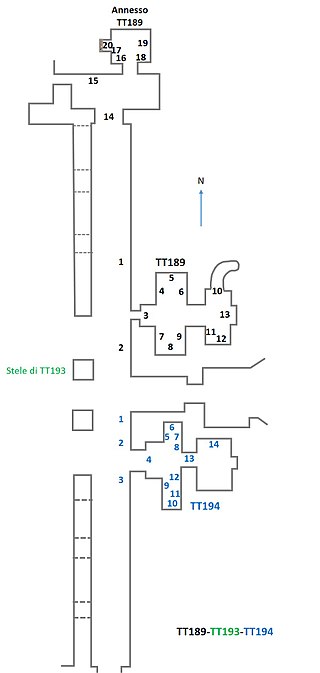
Nefertari, also known as Nefertari Meritmut, was an Egyptian queen and the first of the Great Royal Wives of Ramesses the Great. She is one of the best known Egyptian queens, among such women as Cleopatra, Nefertiti, and Hatshepsut, and one of the most prominent not known or thought to have reigned in her own right. She was highly educated and able to both read and write hieroglyphs, a very rare skill at the time. She used these skills in her diplomatic work, corresponding with other prominent royals of the time. Her lavishly decorated tomb, QV66, is one of the largest and most spectacular in the Valley of the Queens. Ramesses also constructed a temple for her at Abu Simbel next to his colossal monument there.

The Battle of Kadesh took place in the 13th century BC between the Egyptian Empire led by pharaoh Ramesses II and the Hittite Empire led by king Muwatalli II. Their armies engaged each other at the Orontes River, just upstream of Lake Homs and near the archaeological site of Kadesh, along what is today the Lebanon–Syria border.

The New Kingdom, also referred to as the Egyptian Empire, was the ancient Egyptian nation between the 16th century BC and the 11th century BC. This period of ancient Egyptian history covers the Eighteenth, Nineteenth, and Twentieth Dynasties. Through radiocarbon dating, the establishment of the New Kingdom has been placed between 1570 BC and 1544 BC. The New Kingdom followed the Second Intermediate Period and was succeeded by the Third Intermediate Period. It was the most prosperous time for the Egyptian people and marked the peak of Egypt's power.

Meritamen was a daughter and later Great Royal Wife of Pharaoh Ramesses the Great.

Ramesses was an ancient Egyptian crown prince during the 19th Dynasty.

Ramesses II, commonly known as Ramesses the Great, was an Egyptian pharaoh. He was the third ruler of the Nineteenth Dynasty. Along with Thutmose III of the Eighteenth Dynasty, he is often regarded as the greatest, most celebrated, and most powerful pharaoh of the New Kingdom, which itself was the most powerful period of ancient Egypt. He is also widely considered one of ancient Egypt's most successful warrior pharaohs, conducting no fewer than 15 military campaigns, all resulting in victories, excluding the Battle of Kadesh, generally considered a stalemate.

Pareherwenemef was an ancient Egyptian prince of the Nineteenth Dynasty of Egypt, the third son of Pharaoh Ramesses II, the second by Queen Nefertari.
The Theban Tomb TT168 is located in Dra' Abu el-Naga'. It forms part of the Theban Necropolis, situated on the west bank of the Nile opposite Luxor. The tomb is the burial place of the ancient Egyptian Any, who was a God's Father of Amun and a Chosen lector of the Lord of the Gods during the reign of Ramesses II in the Nineteenth Dynasty.
The Theban Tomb TT170 is located in Sheikh Abd el-Qurna, part of the Theban Necropolis, on the west bank of the Nile, opposite to Luxor. It is the burial place of the ancient Egyptian Nebmehyt, who was a scribe of recruits of the Ramesseum in the Estate of Amun during the reign of Ramesses II in the Nineteenth Dynasty.

Tomb TT189 is located in the necropolis of El-Assasif in Thebes, Egypt. It contains the sepulchre of Nakhtdjehuty, who was an overseer of the carpenters of the northern lake of the god Amun and the head of the goldworkers in the Estate of Amun during the 19th Dynasty reign of Ramesses II. Nakhtdjehuty's tomb is part of the TT192 tomb complex.

The Theban Tomb TT177 is located in El-Khokha, part of the Theban Necropolis, on the west bank of the Nile, opposite to Luxor.

The Theban Tomb TT385 is located in Sheikh Abd el-Qurna, part of the Theban Necropolis, on the west bank of the Nile, opposite Luxor. It is the burial place of the ancient Egyptian Hunefer (Haunefer), who was a Mayor of the Southern City (Thebes) during the reign of Ramesses II in the Nineteenth Dynasty.

Yuyu was an ancient Egyptian High Priest of Osiris at Abydos, during the reign of pharaohs Ramesses II and possibly Merenptah of the 19th Dynasty.

Mose was an ancient Egyptian official who served in the court of 19th Dynasty Pharaoh Ramesses II during the 13th century BC.
Ptahemwia or Ptah-em-Wia was an Ancient Egyptian official who lived under king Ramses II in the 19th Dynasty, around 1250 BC.
Hori was an ancient Egyptian High Priest of Osiris at Abydos, during the reign of pharaohs Ramesses II.
Mery was an ancient Egyptian High Priest of Osiris at Abydos, during the reign of pharaoh Sety I and Ramesses II of the 19th Dynasty.

Tomb TT374, located in the necropolis of El-Khokha in Thebes, Egypt, is the tomb of the Scribe of the Treasury of the Ramesseum, Amenemope.
The Theban Tomb C.7 is an ancient Egyptian tomb in Thebes, Upper Egypt. It is located in Sheikh Abd el-Qurna, part of the Theban Necropolis on the west bank of the Nile opposite Luxor. It is the burial place of the ancient Egyptian Horimose (Harmosi), who was the Head custodian of the treasury in the King's Mansion on the West of Thebes. Horimose, his wife Mutemwia, and a son named Kaemwaset are named in scenes in the Hall of the tomb. One of the scenes shows a row of kings including: Horemheb, Amenhotep III, Thutmosis IV, Amenhotep II, Thutmosis III, Thutmosis II and Thutmosis I.














